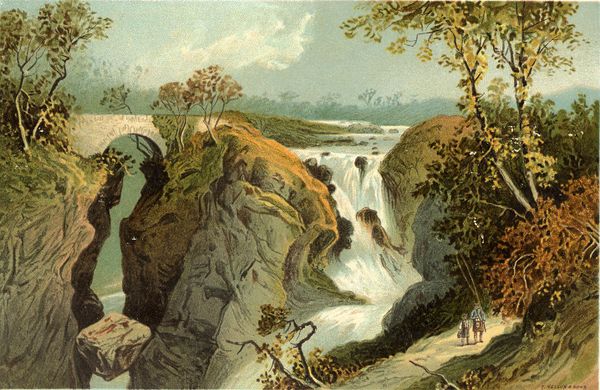Annotation:Rumbling Bridge (The): Difference between revisions
No edit summary |
No edit summary |
||
| Line 11: | Line 11: | ||
<br> | <br> | ||
'''RUMBLING BRIDGE, THE.''' Scottish, Reel (cut time). A Mixolydian. Standard tuning (fiddle). AAB. The melody appears in John and Andrew Gow’s '''A Collection of Slow Airs, Strathspeys and Reels''' (London, c. 1795). Andrew (1760-1803) and younger brother John (1764-1826) established a publishing business in London in 1788 and were the English distributors for the Gow family musical publications. The Rumbling Bridge [https://en.wikipedia.org/wiki/Rumbling_Bridge] is located above a chasm on the Bran south-west of Dunkeld in Perth and Kinross, Scotland, and was originally built in 1713 by William Gray, a mason from Saline. A nearby hamlet takes its name from the structure. The bridge spanned a narrow gorge and the rushing water of the River Devon below makes a constant sound. Later, in 1816 (long after the Gow’s publication), there was a second bridge built on top of the first one, so that it is in effect a double bridge. This wider arch gave greater width to the road and removed the steep gradients down to the old bridge. | '''RUMBLING BRIDGE, THE.''' Scottish, Reel (cut time). A Mixolydian. Standard tuning (fiddle). AAB. The melody appears in John and Andrew Gow’s '''A Collection of Slow Airs, Strathspeys and Reels''' (London, c. 1795). Andrew (1760-1803) and younger brother John (1764-1826) established a publishing business in London in 1788 and were the English distributors for the Gow family musical publications. The Rumbling Bridge [https://en.wikipedia.org/wiki/Rumbling_Bridge] is located above a chasm on the Bran south-west of Dunkeld in Perth and Kinross, Scotland, and was originally built in 1713 by William Gray, a mason from Saline. A nearby hamlet takes its name from the structure. The bridge spanned a narrow gorge and the rushing water of the River Devon below makes a constant sound. Later, in 1816 (long after the Gow’s publication), there was a second bridge built on top of the first one, so that it is in effect a double bridge. This wider arch gave greater width to the road and removed the steep gradients down to the old bridge. | ||
[[File:rumbling.jpg| | [[File:rumbling.jpg|600px|thumb|left|Dunkeld Cathedral and Rumbling Bridge, near Dunkeld, Perth, near the home of family scion Niel Gow.]] | ||
<br> | <br> | ||
</div> | </div> | ||
Revision as of 22:50, 24 April 2018
X:1 T:Rumbling Bridge, The M:C| L:1/8 R:Reel B:John & Andrew Gow - A Collection of Slow Airs, Strathspeys B:and Reels (London, c. 1795) K:Amix d|eATcA c/d/e f2|eAcA BdGB|eAcA c/d/e f2|BGdB eAA:|| g|abag abeg|Bdgd BdGg|abag abeg|BGdB eAAg| abag abeg|Bgdg BdGB|eAcA c/d/e f2|dGdB eAA||
RUMBLING BRIDGE, THE. Scottish, Reel (cut time). A Mixolydian. Standard tuning (fiddle). AAB. The melody appears in John and Andrew Gow’s A Collection of Slow Airs, Strathspeys and Reels (London, c. 1795). Andrew (1760-1803) and younger brother John (1764-1826) established a publishing business in London in 1788 and were the English distributors for the Gow family musical publications. The Rumbling Bridge [1] is located above a chasm on the Bran south-west of Dunkeld in Perth and Kinross, Scotland, and was originally built in 1713 by William Gray, a mason from Saline. A nearby hamlet takes its name from the structure. The bridge spanned a narrow gorge and the rushing water of the River Devon below makes a constant sound. Later, in 1816 (long after the Gow’s publication), there was a second bridge built on top of the first one, so that it is in effect a double bridge. This wider arch gave greater width to the road and removed the steep gradients down to the old bridge.

